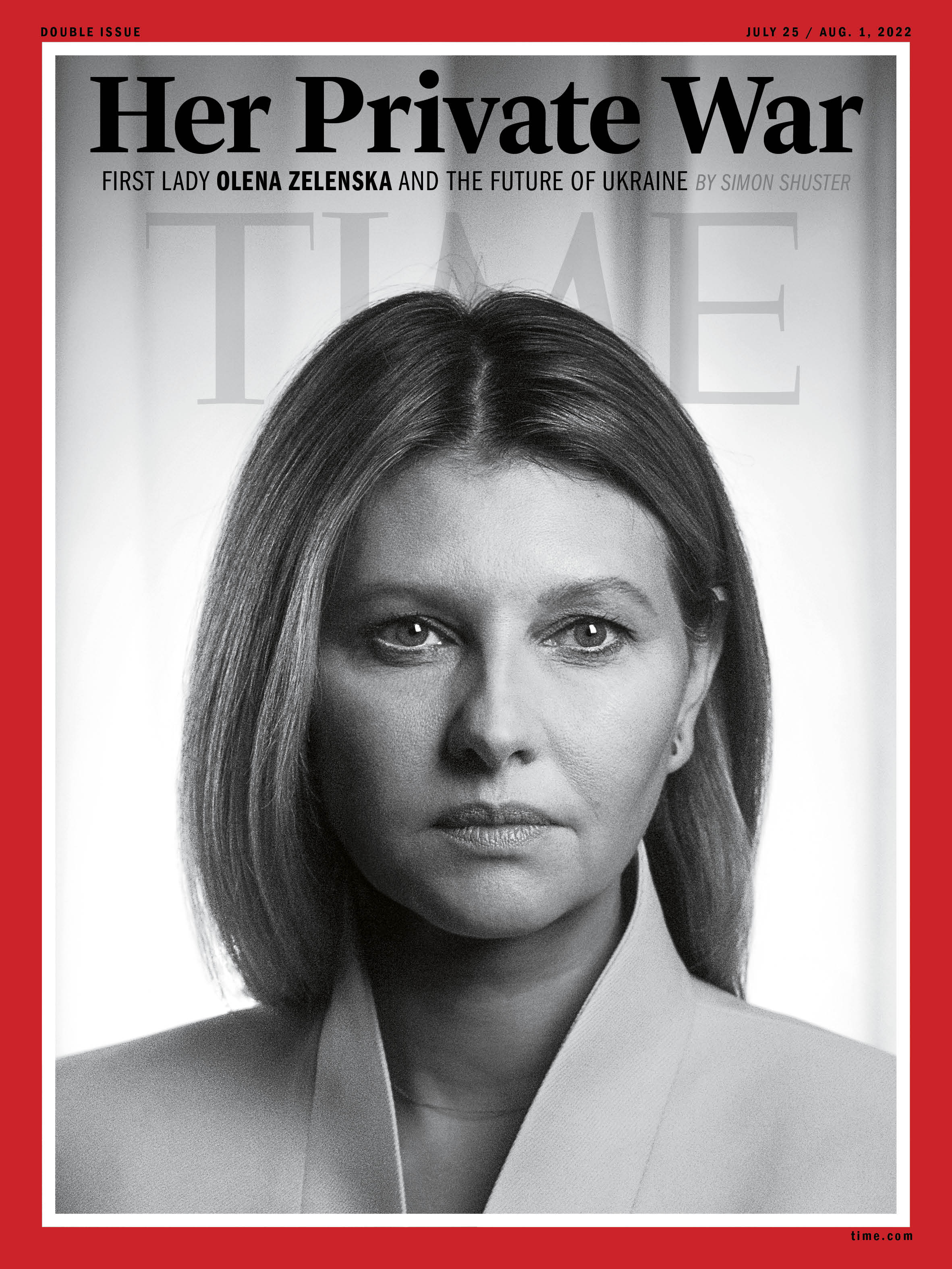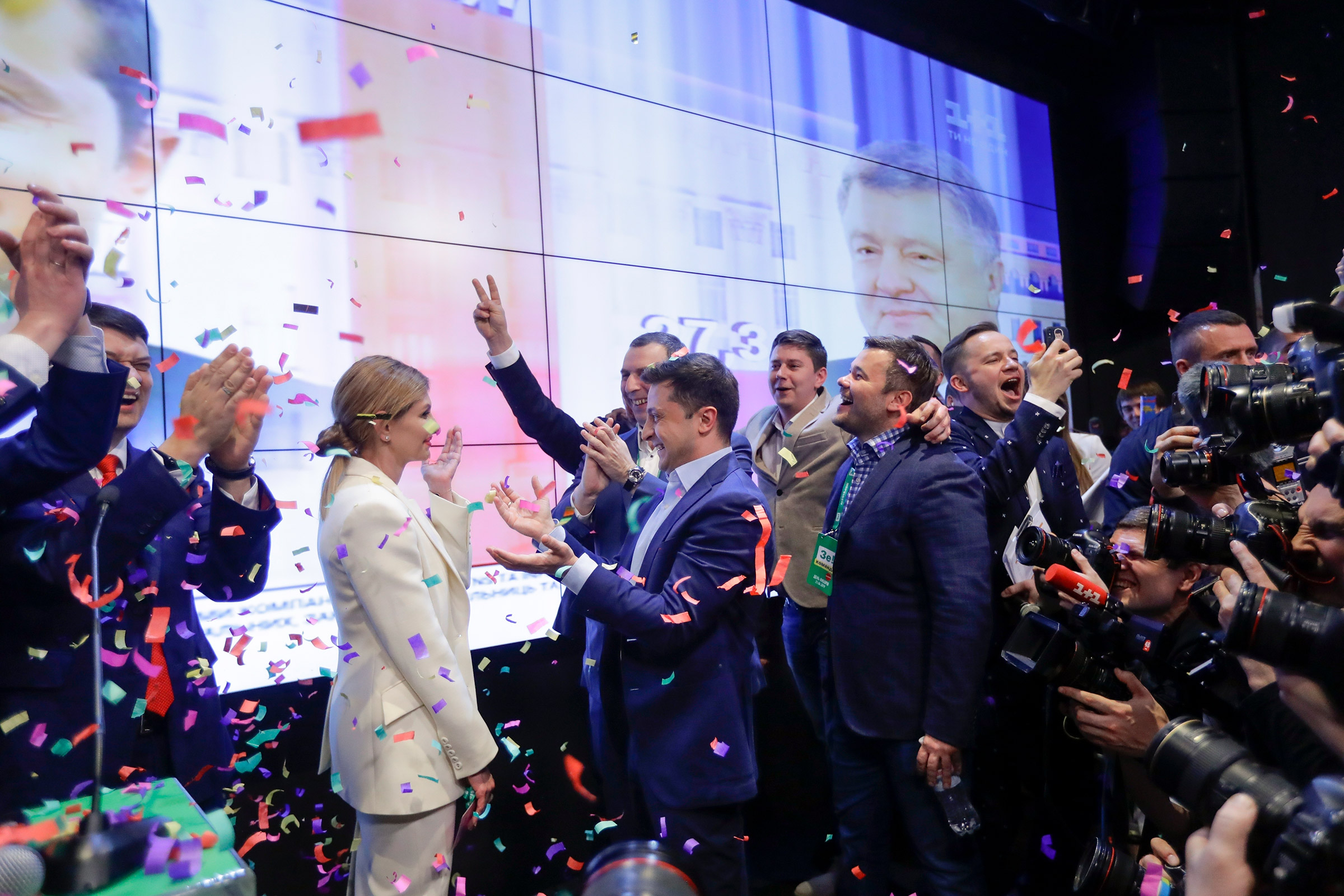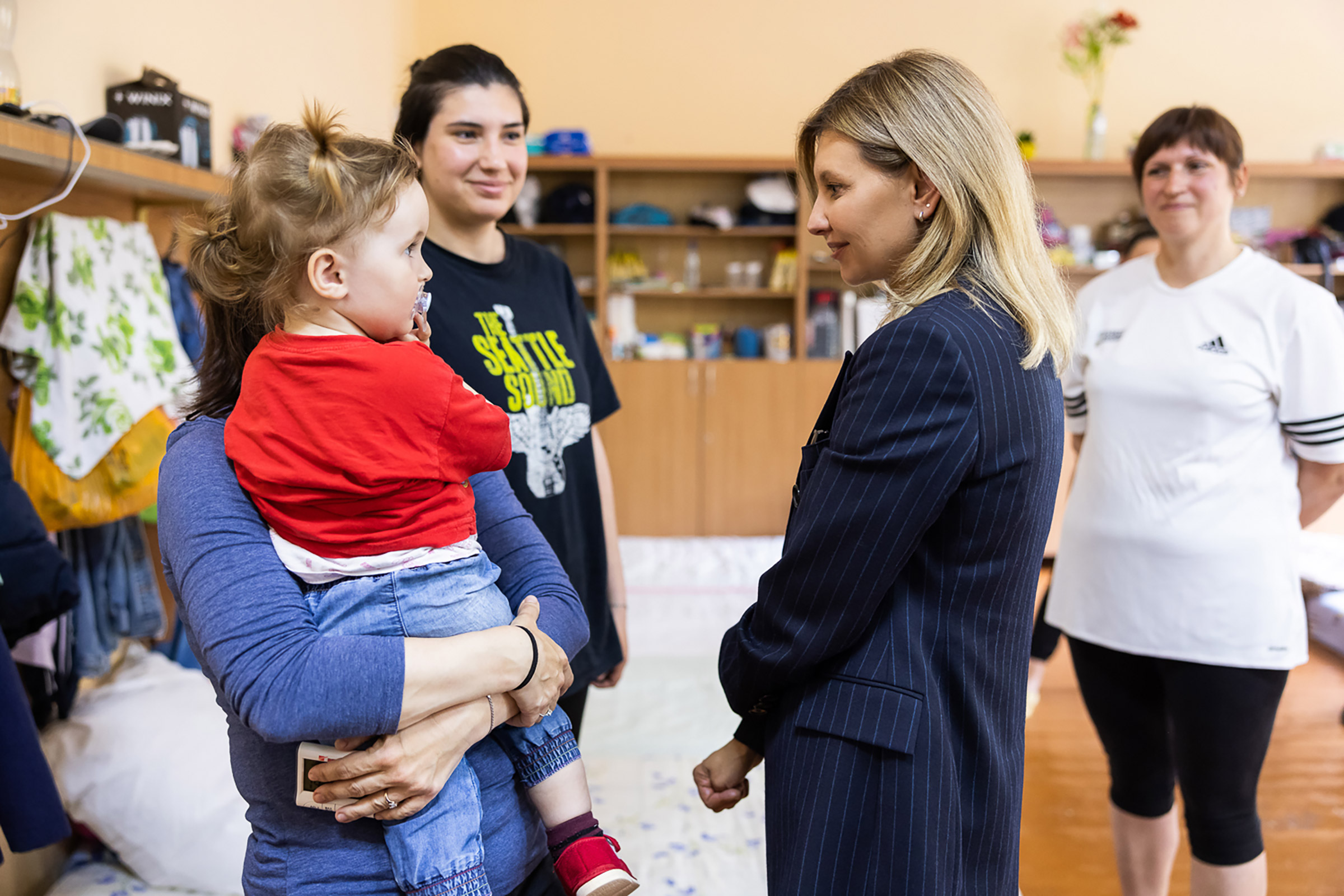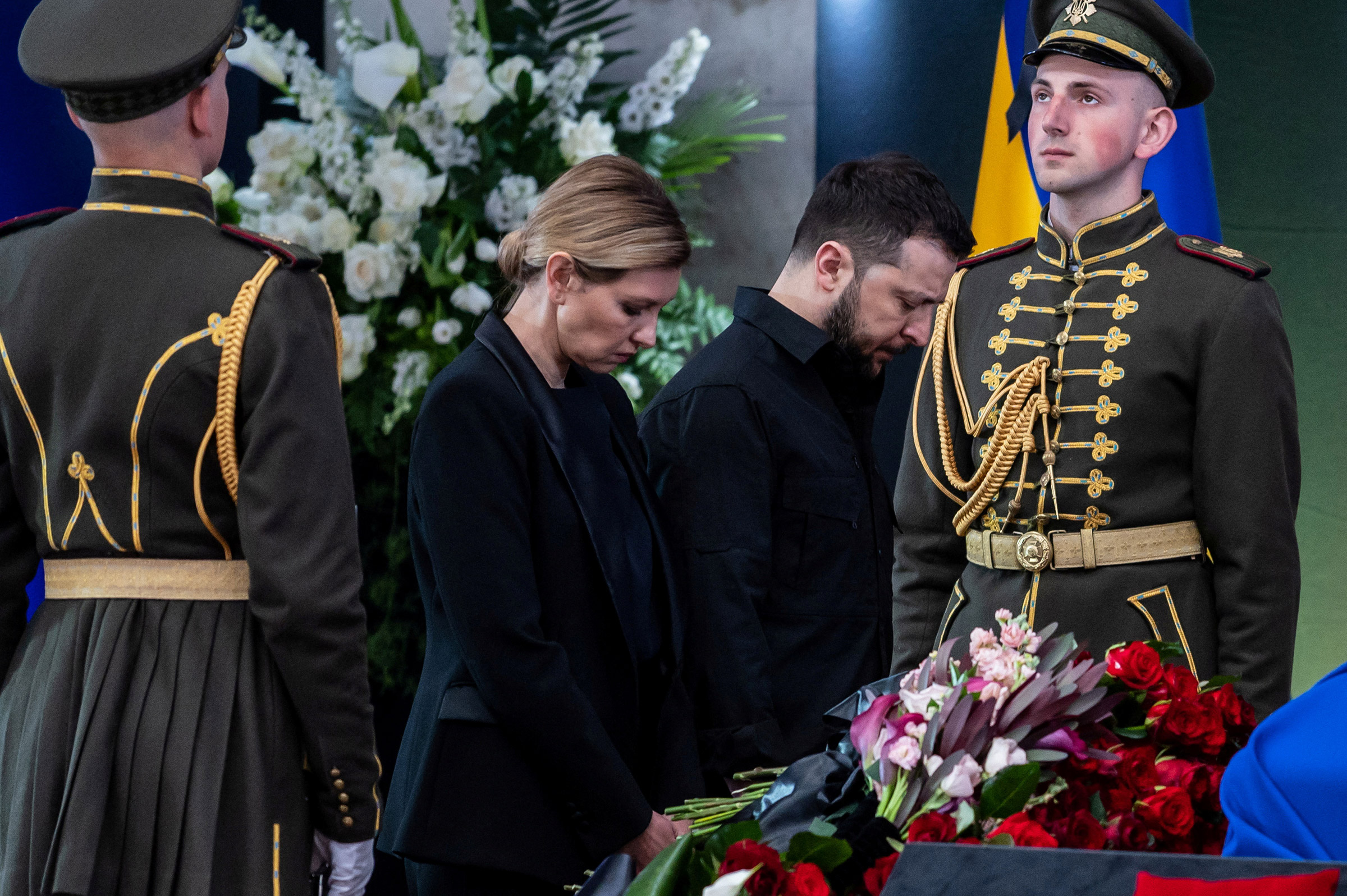Olena Zelenska, the First Lady of Ukraine, got to bed late on the eve of the Russian invasion. Her kids were long asleep in the presidential residence south of Kyiv, a vast mansion of yellow stone that the family had always found a bit too grand, bordering on ostentatious. They had moved there in 2020 because the gated grounds contain a separate building to house their security detail. For days, Zelenska had sensed the bodyguards were nervous. The talk of war, she says, “was everywhere, just kind of hanging in the air.”
The government in Kyiv had urged civilians not to panic, but that had become harder as the Russians massed an invading force that surrounded Ukraine to the north, east, and south. Blogs brimmed with advice for would-be refugees. News programs showed instructions on what to pack while preparing to flee. On the night before the invasion, Zelenska made a note to get a suitcase ready for her family. But she never got around to it.
Neither did her husband Volodymyr Zelensky. The President of Ukraine had seen the intelligence reports—the satellite images, the intercepted phone and radio traffic—indicating the Russians were ready to attack. But he did not believe they would go through with it, and he did not urge his wife to get ready just in case. When they went to bed on Feb.23, Zelenska says, she did not imagine it would be the last time they would sleep side-by-side for months.

Buy a print of the ‘Her Private War’ cover, featuring Olena Zelenska
The Russian attack began before dawn the next day, and it split the First Family much like millions of other Ukrainians. Zelensky stayed in his compound in central Kyiv to lead the country, while his wife went into hiding with their two children. Her projects to improve the nation’s education and health care had to be halted, as was her career as a screenwriter. Surrounded by soldiers, she was seldom sure where she would sleep on any given night.
But 10 weeks into the invasion, Zelenska emerged from hiding, and she has since found her voice as a wartime leader of a different kind. While her husband has focused on securing weapons and other support from the West, the First Lady has devoted herself to helping the country cope with its traumas, both collective and personal. In May, she launched a government initiative to make psychological support available to every Ukrainian. It has now begun training trauma counselors, setting up mental-health hotlines and tapping foreign experts for clinical support.
Read More: Inside Volodymyr Zelensky’s World.
The psychic toll of the war is overwhelming. Ukraine’s Health Ministry estimates that 15 million people—nearly a third of the population—are likely to require mental-health care. Some 8 million have been displaced by the war, the vast majority of whom are women and children. The number of military personnel has roughly tripled since the start of the invasion, to more than 700,000, and many of them are likely to experience trauma during their service. “There could be enormous consequences for the country,” Zelenska tells TIME in an interview at the presidential compound on June20, “if we end up with posttraumatic stress that goes untreated after the war.”
The Ukrainian armed forces will need help screening soldiers for signs of posttraumatic stress. Convincing regular Ukrainians to seek care will also be a challenge. When Zelenska, 44, talks about her efforts in this field, she often borrows the English phrase—mental health—because the concept is hard to describe in Ukrainian. “We have a particular distrust for terms that include the word psycho,’’ she says, in the muted gray rooms that now serve as her headquarters, down the hall from the Situation Room where her husband gets briefings from his generals. Ukrainians associate the practice of psychotherapy with state-run asylums, places that are designed to isolate the ill from society. A lot of that stigma, Zelenska says, has its roots in the Soviet Union, where generations of Ukrainians were raised to deal with trauma by hiding it away. The attitude, she says, was “Deal with it, get over it, and if you complain, you’re weak.”

The trauma of the war began for Zelenska before dawn on Feb. 24, when the rumble of explosions shook her awake. She got out of bed and found her husband in the next room, already dressed in a suit for work. “Emotionally he was like the string on a guitar,” she says: taut to the point of snapping. But there was no fear or confusion on his face, she recalls. “He was completely together, focused.”
They spoke only for a few moments. The President told her that the war had started. “He had nothing else to say,” Zelenska recalls, “and I didn’t know what to ask.” He promised to call her later that day with instructions on what to do next.
By the time the President rushed out the door, the children were awake, and seemed to understand what was happening. Kyrylo, age 9, obeyed his mother with a quiet intensity, stuffing a few of his things into a little rucksack: some markers, a puzzle book, pieces of a partially assembled Lego set. His sister, Oleksandra, 17, was in touch with her friends through social media, trying to get a better sense of what was happening outside.
About a hundred miles to the north, the Russian forces had exploded across the border around dawn, aiming to encircle the capital and overthrow Zelensky’s government. From the air, Russian paratroopers were descending on Kyiv and trying to seize the airports. Ukrainian troops and volunteers were putting up a tenacious fight. At one point that morning, as the First Lady stood at the windows of the presidential residence, a fighter jet tore through the sky, flying low enough for her to feel the sound inside her rib cage. The security guards told the family that they needed to go down to the basement. There was a risk the Russians would bomb them from the air.
Read More: TIME’s Interview With Volodymyr Zelensky.
Zelenska and the children did not want to flee. When the President called, she told him that they felt safer at home than in some secret location, and they did not want to leave their pets behind: two dogs, a cat, and a neurotic parrot named Kesha. But there was no sense in arguing. The family’s address had been made public in media reports. So the First Lady packed the family’s things into one roller suitcase, and they drove to the presidential compound to say goodbye to Zelensky.

By the time they arrived, the President had decided to remain in Kyiv. His team was busy setting up a command center in his office and in the Situation Room on the second floor. The farewell was unsentimental. The family did not even step into a private room to talk. They hugged in the hallway, exchanging a few hurried words while aides rushed past. “It was a calm conversation for the road,” she says. They were both performing for their children at that moment, trying to make them believe there was no reason to panic.
Both of them understood the danger. Western intelligence agencies had warned Zelensky that the Russians were aiming to kill or capture him. “The enemy has marked me as target No. 1,” the President said in a video address on the second day of the invasion, “and my family as target No. 2.”
To minimize the risk of assassination, Zelenska and her children had to get off the grid. They could not bring along their mobile devices or log in to their social media accounts, which could be used to track them. Before leaving the compound, Zelenska posted a message on Facebook, addressed to the people of Ukraine. Parts of it read like a plea to herself. “Today I will not panic and cry. I will be calm and confident,” she wrote. “My kids are watching me.”
Friends in Europe offered to host the family for the duration of the war. But Zelenska and her children were not spirited out of the country. Nor were they locked inside some secret bunker underground. They stayed in Ukraine, but were forced to move around to stay ahead of security threats. “You just hope that you’re safe right now,” she says of her mindset in those early days. “You don’t know what will happen in two hours.” The uncertainty gave rise to a habit of making the most of the amenities in the places where they were taken, she says, “because you don’t know when else you will have time, and when you will next get to a normal shower.”
Due to security concerns, they were not allowed to communicate with the President through video calls. For weeks they spoke only on secure phone lines, which had to be arranged in advance. Yet they saw plenty of him on television. Despite the difficulty of the topics the President addressed in his speeches, the nightly appearances were a comfort to his children. “They could see that dad was at work and looked all right,” says Zelenska. “There was some stability in that.”
But it was difficult for her to continue working. Her campaigns in the field of education, like a program to improve school lunches, had to be put on hold as schools around the country closed. Zelenska also paused her career as a screenwriter for comedy shows, which she had continued to do while serving as First Lady. “Before the war I could do both,” she says. “Not anymore.”

The first days of the invasion left little room for sorrow. It was too surreal and disorienting. Zelenska coped by wearing a mask of optimism. Soon, though, the adrenaline began to wear off, and the horrifying reality of their situation came into focus. The Russians had already swept across vast regions of southern and eastern Ukraine, and their tanks were moving southward to encircle the capital. Millions of Ukrainians were fleeing the war, including many of the family’s closest friends.
“I understood that I may never see them again, all the ones I love,” Zelenska wrote to Vogue in April. She had trouble reaching loved ones, and could not figure out where they were, or even whether they had survived. “That was probably the first time when I cried, the first time I let my emotions go. I just couldn’t take it.”
Read More: A Ukrainian Photographer Documents the Invasion of His Country.
By the second week, Zelenska and the children had settled into a routine. Kyrylo did schoolwork and spent hours drawing. Some of his pictures worried his mother. Instead of the usual sketches of Batman and Spider-Man, he depicted scenes of war and destruction. Oleksandra, whom the family calls Sasha, followed the news and helped cook the family’s meals. The ban on using social media did not prove as difficult for the 17-year-old as her mother had expected. “It was all right,” Zelenska says of her daughter. “It turns out her phone addiction was not all that strong.”
Over time, the security protocols eased enough to allow the family to access the internet. Zelenska was able to track her husband’s pronouncements and other sources of information about the war. The news they delivered, combined with the sound of air-raid sirens, often kept her from sleeping. “It’s a revolting habit,” she says, “reading the news at night.”
Read More: The Crime Scene Russians Left Behind At a Summer Camp in Bucha.
Millions of Ukrainians have been living that way for months, absorbing waves of dread and tragedy through their screens. One story hit Zelenska particularly hard. In early May, she read a few pages from the diary of an 8-year-old boy who had survived the Russian siege of Mariupol, a port city on the Black Sea that has been reduced to rubble by Russian bombardment. “My two dogs died,” the boy wrote in one entry. “So did my grandma Galya, and my beloved city.”
The boy’s story brought home the depth of the trauma that Ukraine’s children are facing. “Imagine how this could affect the psyche of a normal child, who was not raised for war, not taught to hate,” the First Lady says. “And there are thousands of these children.” It will be a generational challenge to help them heal after this war, and Zelenska has tried to make that challenge her own.
On May 8, Mother’s Day, Zelenska emerged from hiding to meet Jill Biden, the American First Lady, at a school in western Ukraine that had been turned into a shelter for displaced families. The appearance marked the start of a new role for Zelenska. She has since become a vocal and visible advocate for Ukraine’s defense on the international stage. Much of her work has focused on empowering organizations that specialize in the treatment of trauma and connecting them with state institutions, like the Ministry of Health, that can facilitate care for people who need it.

After more than two months in hiding, she is making up for lost time. Her days are packed with speeches, meetings, panel discussions, and interviews. Her peers from around the world have offered to help. The First Lady of Israel, Michal Herzog, has helped Zelenska create training programs for Ukrainian trauma counselors. The First Lady of Poland, Agata Kornhauser-Duda, has worked closely with Zelenska to aid Ukrainian refugees. “This club of ours has been a big help,” Zelenska says. “We understand each other.”
Read More: Inside the Historic Mission to Provide Aid and Arms To Ukraine.
She and her husband still live apart, and Zelenska understands that her family has little hope of returning to normal while the war rages. When they reunited briefly in May, the children clung to Zelensky, savoring the chance to hug him for the first time in months. “It was touching,” the First Lady says. “But I can’t tell you more than that.” She only admits that they still see him most often on television and they have not been able to return to their family routines of watching movies and sharing meals.
In some ways the separation feels appropriate. Millions of families have been divided in Ukraine. Like them, the Zelenskys will need emotional support as the fight grinds on and the casualties mount. “Every day you read about them, you hear about them, you absorb it, and it has an effect,” says the First Lady. “Each of us, including myself, have felt that our psychological state is not what it should be.” After four months of war, she adds, “none of us are OK.”
With reporting by Mariah Espada and Simmone Shah/New York
More Must-Reads from TIME
- Cybersecurity Experts Are Sounding the Alarm on DOGE
- Meet the 2025 Women of the Year
- The Harsh Truth About Disability Inclusion
- Why Do More Young Adults Have Cancer?
- Colman Domingo Leads With Radical Love
- How to Get Better at Doing Things Alone
- Michelle Zauner Stares Down the Darkness
Contact us at letters@time.com
